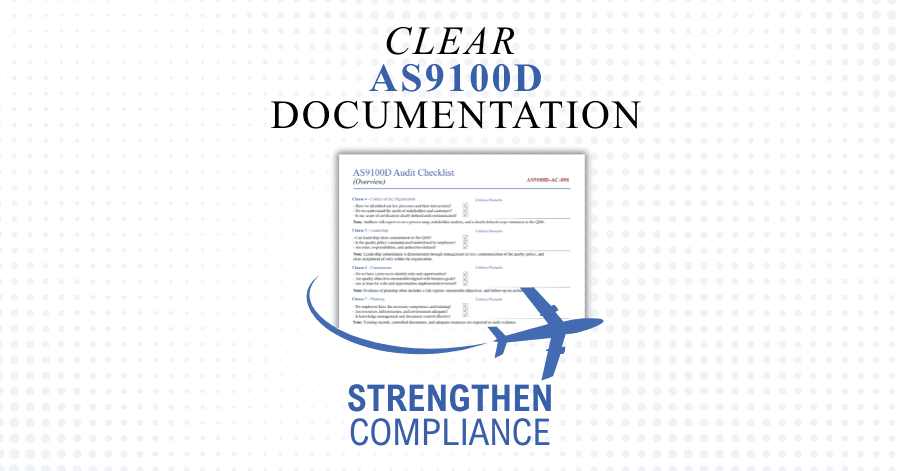Introduction: Why Documentation Defines Compliance
AS9100D documentation clarity is the backbone of compliance. Auditors evaluate how well procedures, forms, and records reflect real work practices. If documents are inconsistent, outdated, or unclear, it signals poor control—even when processes are effective. Clear documentation proves your organization manages information, responsibilities, and evidence with discipline.
The Link Between Clarity and Audit Performance

When documents are easy to follow, auditors spend less time interpreting and more time confirming compliance. Each controlled document should tell a consistent story: defined purpose, scope, responsibility, and revision history.
Ambiguity often leads to audit findings, while precision demonstrates maturity and control of your quality system. Clear documentation eliminates guesswork during audits. When instructions are written unambiguously, employees perform tasks consistently, auditors verify conformity faster, and deviations are easier to trace. Precision also reflects disciplined process ownership—each clause, procedure, and form has a defined purpose, current revision, and accountable owner. This level of control signals a mature quality management system capable of sustaining compliance and continuous improvement under AS9100D standards.
Key Elements of Clear AS9100D Documentation
- Consistent formatting: Use identical structure, fonts, and numbering across all procedures.
- Defined revision control: Each update must show who approved it, when, and why.
- Accessible procedures and records: Controlled copies should be easily retrievable by authorized personnel.
- Direct clause linkage: Identify which AS9100D clause each document supports.
- Plain language: Technical terms are fine, but avoid unnecessary jargon.

What Internal Auditors Often Find
As internal auditors, we have repeatedly seen files stored incorrectly—active forms mixed with obsolete versions in daily-use folders. Outdated records often remain accessible under “Current” or “Active” directories, creating confusion and nonconformities. An effective practice is to establish a clear Archive or Obsolete Documents folder within your document control system. Each retired file should be moved there immediately upon release of a new revision. This separation prevents accidental use of outdated forms and demonstrates full control of documented information under AS9100D Clause 7.5.
How Poor Documentation Causes Nonconformities
Common issues include missing signatures, conflicting versions, and outdated instructions still in use. These gaps create traceability problems and suggest a lack of process control. Even when operations run smoothly, unclear documentation can produce avoidable findings during surveillance or recertification audits.
Practical Steps to Improve QMS Documents
- Standardize your templates.
- Perform periodic documentation audits to confirm relevance and version accuracy.
- Implement a document numbering system that reflects process ownership.
- Use digital document control tools to track revisions and approvals.
- Train employees on controlled document use, retention, and archiving procedures.
Tools for Document Control and Traceability
Digital tools streamline compliance. Controlled folders, fillable PDF forms, and electronic signatures reduce errors. Document registers can link each file to its clause, owner, and revision date, ensuring traceability and rapid retrieval during audits. Even small organizations benefit from structured document design that mirrors the rigor of larger aerospace suppliers.
Final Thoughts: Documentation as a Quality Signal
Clear AS9100D documentation is more than a compliance requirement—it is a visual indicator of organizational control. Every formatted page and version number communicates how seriously your company treats quality. When documents are accurate, consistent, and properly archived, auditors notice, customers trust, and the entire QMS becomes more resilient.

Ronnie Lee Roberts II has worked in the Department of Defense (DoD) quality environment since 2017, supporting programs at Patuxent River and Webster Field (NAWCAD/NAVAIR). A certified AS9100:2016 Rev D Lead Auditor (2022–2025), he brings deep knowledge of quality management systems, documentation control, and audit readiness across aerospace and defense operations. His background includes hands-on experience inspecting to specification per engineering drawings and customer requirements, verifying process conformity, and maintaining compliance with AS9100D clauses related to documented information, product realization, and risk management.
In addition to audit work, Ronnie has supported QMS development, technical writing, CAD-based documentation, and controlled record structures that ensure traceability and repeatability. He also holds ISO/IEC 20000-1:2018 Lead Auditor (TPECS, 2023) and Certified CMMI® Associate (2025) credentials, supporting CMMI-DEV Level 3 environments. His focus remains on aligning documentation and inspection practices with AS9100D standards to drive measurable quality performance and readiness for customer and regulatory audits.

